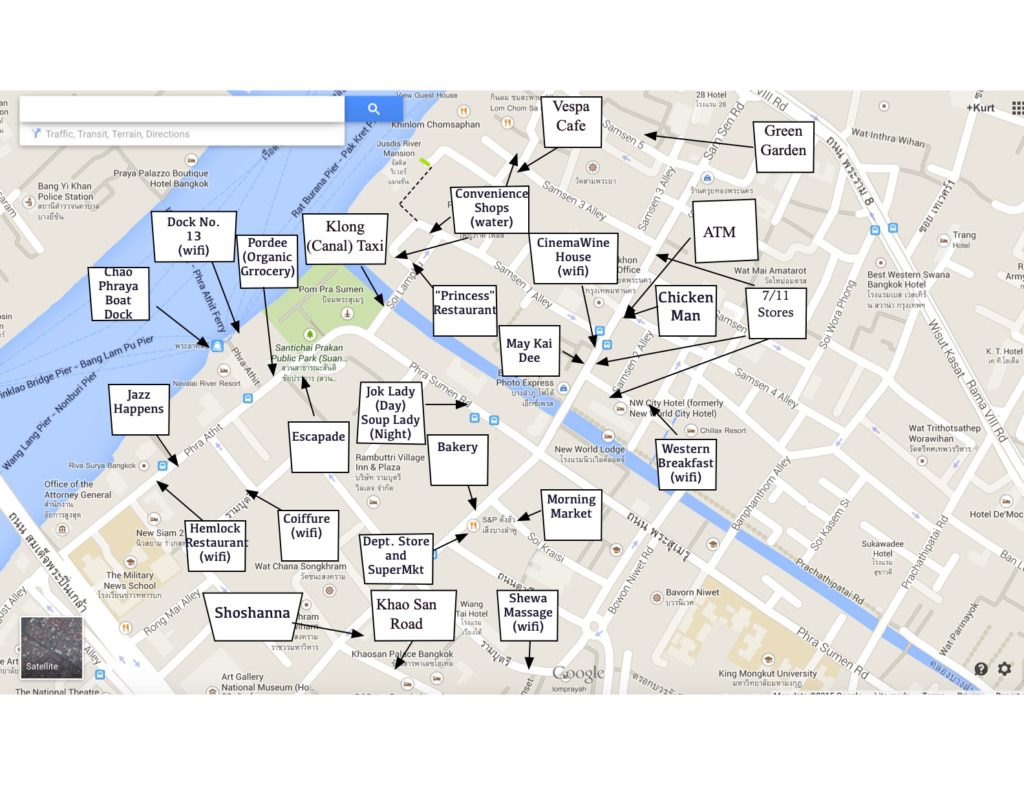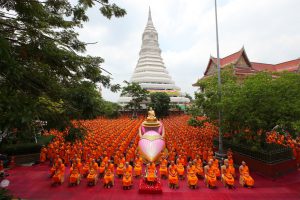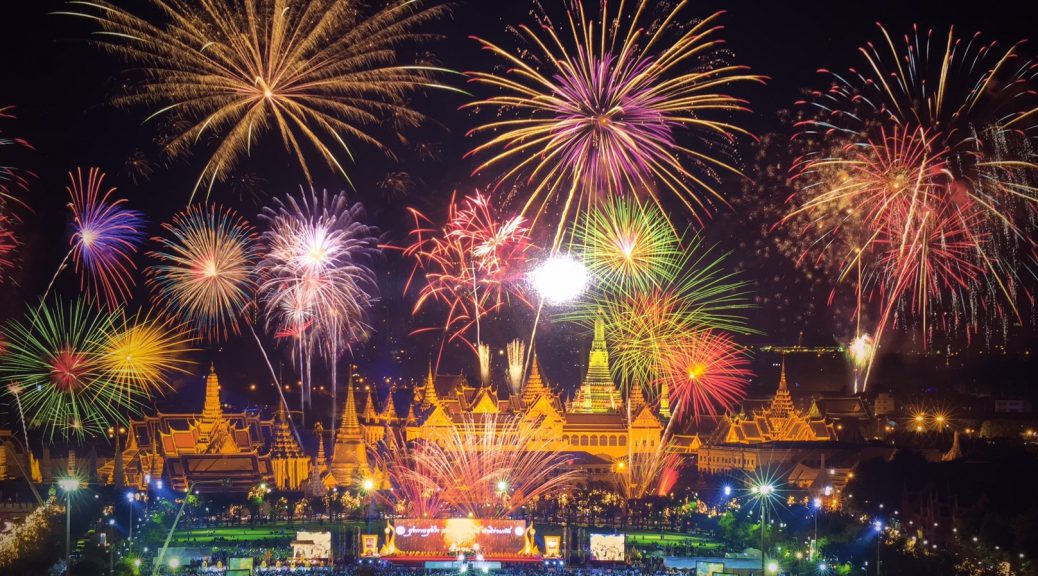In Bangkok
There are myriad ways to get from one place to another in Bangkok – taxis, buses, subways, skytrains, canal (klong) boats, Chao Phraya Express boats, Tourist Boats, long tail boats, Grab Taxi (which has merged with UBER), tuktuk’s, motorcycle taxis, river ferries, and minibuses (called songthaews, pronounced ‘song tao’), not to mention tour buses. private town cars and limousines. It is also possible to rent a car if you plan to travel around Bangkok, but we highly advise against it. Only those familiar with the labyrinthian maze of Bangkok roadways should undertake driving themselves.
TAXIS and GRABTAXI – If you want to use GRABTAXI, you’ve got to get a Thai SIM card at the airport – which is easy to do it you’ve got an unlocked phone. Uber used to be our personal favorite mode of transportation in and around town but they merged with GRABTAXI Three caveats – first, don’t bother with GRABTAXI getting from the airport into town. Get a taxi from the ground floor of the airport. It will cost only about $9 to get the 25 kilometers from the airport to the central part of town. Second drivers may not know the section of the city where you need to travel, so either print out a hardcopy map or use Google Maps on your phone to show the driver where you want to go. And third, it’s hard to find cars during high traffic periods, and be aware that when you can find one, the system will automatically double or even triple normal rates for peak traffic hours .
Unless you’re somewhere your hostelry’s staff can call a taxi for you, the way most travelers get a taxi is to go to the nearest thoroughfare and hail a taxi that has a red light illuminated in the window – which means it’s available.
Taxis are widely available throughout the city, and by law they are obliged to charge by the meter. But don’t count on it – particularly if you’re trying to hail a taxi during peak traffic hours or from touristy areas. The way to ensure you’re getting the best rate is to tell the driver where you want to go (again, carry a map), and then ask “Taxi-meter?” Don’t be surprised if the driver shakes his head and drives off.
For tips on negotiating a price, see the SPOKEN THAI NUMBERS post.
Note: to use GrabTaxi you’ll need to download their cellphone application. Using the app will cost you a 50 baht premium. Unless you’re somewhere far from a main thoroughfare, it’s generally easier to just stand alongside a road and hail a taxi. And don’t count on GrabTaxi during peak hours – drivers have to use TaxiMeter for GrabTaxi, and they can make more money during rush hour by negotiating premium prices with their prospective fares.
BUSES. If you want to stretch your dollar the farthest, the cheapest and most flexible mode of public transport is the bus system. There are four flavors of buses in Bangkok as of Nov. 2018 – the air conditioned cream and blue buses cost from 11 baht to 24 baht, depending on the distance travelled. Yellow air conditioned buses cost 10 -12 baht. Two toned white/ blue buses are not air conditioned and cost 8 baht; and red buses cost 7 baht. To find out where buses go, refer to http://www.transitbangkok.com/bangkok_buses.html
BOATS. are as cheap as buses, but more limited in their routes, are boats. To travel north and south from the Taksin bridge (a terminal for the SkyTrain), use the Chao Phraya Express boat – 100 ft long boats that carry about 100 passengers at a time, but with seating for only about half the passengers. They cost 15 baht per passenger. They run from 7:00am to 8:00pm, and are a great way to avoid surface street traffic jams at peak hours. The locals take the Chao Phraya Express to the stop closest to where they want to go, and then take tuktuk’s or motorcycle taxis if they’ve got any significant distance yet to travel. Pay careful attention to the flags flown from the rear of these boats – they designate which piers the boats stop at. If you get the wrong colored flag, it may not stop where you plan to go.
Along the same route as the Chao Phraya Express are the Blue Tourist boats. They cost 50 baht as of November 2018, stop at only half the piers along the river, and they are rarely so fully occupied that anyone has to stand. Please note: they only run from 8:00am to 6:30pm.
If you’re fortunate enough to be staying at a place that’s close to the canal that runs east and west about a 1/4 mile north of the central part of town, the klong taxi (klong is the Thai word for canal) is the quickest way to travel. It costs 12 baht between western end of the canal at Golden Mount and the Platinum shopping center, and another 12 baht from Platinum going east. We live a mile from the canal, and walk or take a tuktuk to the Golden Mount, then the long taxi, and then a tuktuk or motorcycle taxi into the city center proper – total cost about $3 USD.
RIVER FERRIES. At piers where the Chao Phraya Express and Tourist Boats stop and there are no bridges nearby, you can expect to find a ferry that will take you to the opposite side of the river. They normally cost 5 baht (about 15 cents).
MOTORCYCLE TAXI. By far the quickest way around Bangkok is by motorcycle taxi. But this is not transportation for the timid. These daredevils will spirit you through traffic jams weaving between lanes of traffic, with millimeters between their handlebars and the vehicles on either side. Don’t be surprised if your journey includes bits of back-alley travel or traffic island transits – your driver will do anything and everything to get you to your destination as quickly as possible so he or she can get the next fare. There are literally thousands of these motorcycles around the city, easily recognizable by their drivers’ orange vests banded with reflective tape. The drivers do not speak English – so bring a map (cellphone maps are great). Before you get on the bike, make sure to agree to a price. The driver will quote you a price in Thai (See the SPOKEN THAI NUMBERS post for tips on negotiating prices), and if you’re well dressed you can expect the price will be twice what the locals will be asked to pay. But even if you have little stomach for negotiating, the price will still be cheap by US standards.
TUKTUKS. These iconic three-wheel open-air taxis are a favorite with both the locals and tourists. But there are a number of things to keep in mind in considering whether to use them. First, they are open air – which not only means they are uncomfortable when it’s hot, but it also means you’re exposed to all the exhaust fumes of the cars and buses and motorcycles around you. We only take them for relatively short trips, and then only during non-peak hours when the air quality is good. And never when it’s raining. And, like motorcycle taxis, arranging the fare is something that needs to be done before you embark. Sometimes (but rarely) the driver will speak English, and almost always he’ll charge you based on the quality of the clothes you’re wearing. If you like negotiating, you’ll love haggling about the fare. (See the post on SPOKEN THAI NUMBERS)
SKYTRAIN. As of 2018 there are three BTS Skytrain lines. The first line called the Airport Rail Link, and runs from the Suvarnabhumi Airport to the Phaya Thai terminal on the north south BTS line. It costs 55 baht if you take the local or 150 baht if you take the express train. Don’t take this from the airport to town unless you’re traveling alone and have light luggage. (It costs less for a cab from the airport with two people than the express skytrain.) To transfer from the Airline to the Skytrain requires a separate fare.
The other two BTS lines interconnect and on one line you can buy a fare that includes a transfer to the other. One line runs roughly south to North, and the other runs west to east. The two lines intersect at the Siam station. Fares on those lines run from 22 baht to 55 baht, depending on distance travelled. The trains are immaculate, but usually packed with commuters – so count on standing during your commute. (See Note 1 about pickpockets.) These trains take you right through the heart of the central business district, and connect with the Chao Phraya Express and Tourist Boats (at the Central Pier) and with the klong taxi (about a 7 minute walk from the Hua Chang boat pier to the National Stadium Skytrain terminal).
MTS SUBWAY. The very fastest way around town is the subway, but there is only one subway line and it circles the city. The closest it goes to the heart of the city takes a transfer to the Skytrain and another 32 baht. It’s cheap for seniors (about 15 baht), and more expensive for regular commuters (55 baht). And it does not run late hours – refer to the internet for times on weekdays and weekends.
LONGTAIL BOATS. The are for the most part tourist traps. But there are some places you can’t go unless you get one. If you want to tour a wonderful orchid nursery, go to Pier 13 (Phra Arthit) and ask the ladies at the ticket counter to point out the fellow who brokers tours. He’ll have a boat for you within 20 minutes. Along the way you’ll get to buy snacks from ladies selling from their floating market, and you’ll have the opportunity to feed the ravenous fish in one of the tributaries to the Bangkok Noi canal. The temples and homes on the side canals are a slice of Bangkok that you can’t see any other way. The trip will set you back 1,500 baht or so ($40-45) for 2 or more people, but it’s one of the tours that is truly unique.
MINIBUSES (SONGTHAEWS) – Refer to the section below, Outside Bangkok.
Outside Bangkok
Songthaews (need a local who speaks English)
Busses
Trains
Car rentals
[Note 1] Pickpockets abound in every international city, and Bangkok is no exception. Be particularly vigilant when on public transportation or in areas frequented by tourists. When I’m out and about, I keep my cell phone and money clip (including one credit card and my driver’s license) in my pocket, and keep a hand in that pocket at all times – even when jostled by passers-by. The only time I take my hand out of that pocket is when I’m paying for a BTS or subway ticket, or when I’m by myself far from others to talk on my phone.
[Note 2] If you have a cell phone, take a picture of your passport and keep it on your phone. That way you won’t need to carry your passport with you except when you go to a government office on official business – like extending your visa.


